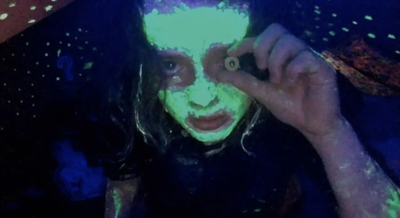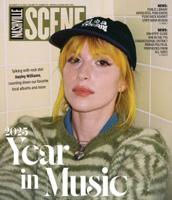A four-step process to alter the body and bring the celebrant into a strange new world, The World’s Fair Challenge is a fast track to something hard to define. Some would say it’s a low-key digital cult, while others might see it as a tear in the illusions that generations use to keep differing perspectives at bay. And some people would just call it the latest iteration of online RPGs to keep parents confused and guessing, shocked by the intimacies of digital lives they are (crucially) unwilling to understand in their dramatic children. Then again, maybe it's just the latest YouTube fad to define this particular two-week period in history.
Casey (Anna Cobb, in a marvel of a debut performance) is an intermittent YouTuber and voyager through the weirder corners of the internet who spends her time avoiding her dad like they’re workers on different shifts at the same job. She’s intrigued by The World’s Fair because her community is intrigued by it. The interest of her audience helps to motivate certain choices, and that’s been a trope of horror cinema for more than a century.
Pokémon Go showed us that there was a genuine disruption in The Real, something waiting in our phones and our shared digital experience that could reshape the world. (Some would say the same about Cambridge Analytica.) A full-on Cronenbergian body transformation is a small and muculent price to pay for forcibly kick-starting the next step of human evolution and adaptation, though invariably someone has to be the Sergey Ushanka who disagrees. But is it bad if the internet is helping you lose your humanity before the economic and social policies of the world get a chance to?
This film unfolds in an indeterminate space of abandoned retail broken up with the occasional forest — there’s somewhere that looks like this in all 48 contiguous states; so you can’t blame the youth of today for finding themselves online. It’s not like the folks running the show have really tried to make things better for them. All you need do is look at what all is being done in the name of "the kids" on a legislative level and you see the frantic grasping of insular tradition trying to keep its wealthy white offspring from learning about or expressing empathy toward anyone not exactly like themselves. So the chance to break out beyond those grabbing hands holds genuine appeal. And Casey recognizes that performance has many meanings as she navigates The World’s Fair and its vague promises of a posthuman shift in existence. For some, it’s becoming plastic. For others, the body becomes a creative site of the surreal. We’re not watching primary-source YouTube videos, so in a sense it’s all artifice, but the other worlds the film spans make The Real an ongoing negotiation between the viewer and what they are seeing.
There’s a reason why horror has been having a renaissance over the past few years. Horror — real horror, not police procedurals gussied up with gore or scare films incapable of even clumsy metaphors (Megan Is Missing, I call you out) — is a possibility of fracturing the boundaries that keep us all locked away in the clutches of The Real. The presence of actual magick or the supernatural (or preternatural, thank you Dr. Markway) is a blessing for a mind ground down by the ostentatious venality of the status quo. Sure, monsters, or curses, or a personification of the abstract made crazily concrete — that means there’s more than just this sad, dying planet where deranged apes with credit scores battle to the end of the European resource allotment board game that human life has become. Horror fractures all of that fatalistic resignation and makes the hippocampus believe in something That Is More. But the super-secret truth that termites away all the foundations that the reactionaries disassembling the public school systems and outreach care for nonwhite and non-straight kids is this: The ceaseless watchers who are the internet generation see exactly what is happening around them. In the way that the slasher boom sprang from baby boomers colliding with the brick wall of parenthood, the horrors of The Now are way too all-encompassing for just one psycho in a mask to successfully embody, and the pitiless game of performing normality that seems to be the goal throughout the country is so much more horrifying than lurking figures and the mysteries of the flesh.
Science fiction, horror’s slightly more respectable elder sibling, falters in this context because we’ve seen what happens to science in the public sphere during COVID — and to be truly transformative requires a plausibility that can’t be shaken by the opinions of others. That's also why this film’s single explicit act of violence (against a stuffed lemur) hits very hard; every imaginative person has that reading of The Velveteen Rabbit that has been stuck in the cerebral cortex since before they could read, and it seems like every film that wants a fast signifier for the end of childhood positively delights in shredding avatars of the cute. That irrational assignment of Real that the inchoate love of young hearts radiate like a nuclear reactor is the kind of transformative energy that unmakes bodies and reshapes worlds.
Like The Empty Man, We’re All Going to the World’s Fair is a film that hides deep inside an easy précis — a creepypasta carapace that hides something more primeval and slippery that unmakes your certainties. And like the past 30 years of Candymen, the hook is sharp and gets you from the beginning, something viral and participatory; all too easy to do, yet difficult to resist. But We’re All Going to the World’s Fair understands all too well that the existential unease of youth itself, hormonal and chaotic and deeply rooted in truly becoming aware of the passage of time, is the foundation of true horror. Writer-director Jane Schoenbrun’s film is a perceptive, haunting dive into the digital subconscious, the face and metadata of the next path in transformative fantasy terror. On a screen, in a theater, the emotions are so very much. Never exploitative, the film’s intimacies are too real to ignore. It isn’t hard to see this becoming the new Blair Witch Project, in that the unimaginative will slag it and it’ll still become one of the most influential genre films of however long we have left.
Schoenbrun and their cast and crew have hammered out a mode of storytelling that feels immediate and alive in a way that makes old folks like me nervous. But Wes Craven would have loved this new New Nightmare, and the shifts in perspective it holds answer myriad questions while making space for oh so many more.





